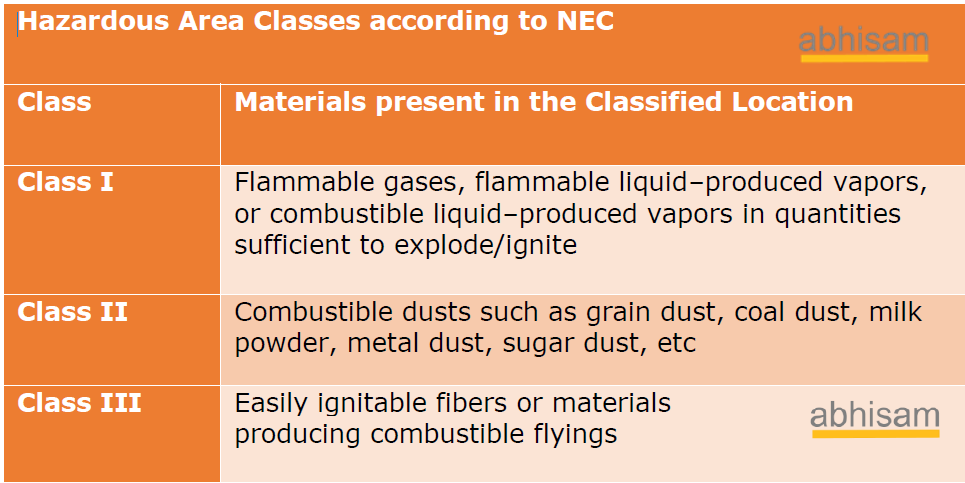You might have come across the term, Class I, Division 2 Hazardous Area. What does it mean?
To understand this, we need to first understand two things- what is a hazardous area and what is a hazardous area classification.
Note: To know in detail about Hazardous Area Classification, please take the Abhisam hazardous area classification course.
Alternately hazardous area classification is also referred to as Electrical Hazardous Area Classification, or simply as area classification. These hazardous areas are also sometimes referred to as ex zones because they use Ex marked equipment. (Zone refers to the Zone classification system used by IEC)
For a short overview of Class and Division, please continue reading.
What is a Hazardous Area?
A Hazardous Area is a location that has a higher risk of explosion and/or fire than a normal industrial area. This is due to the properties of the materials handled or stored there. Hazardous areas are also known as classified locations in the United States.
Chemical manufacturing plants, chemicals storage areas, oil terminals, oil and gas fields, petroleum refineries, tank farms or similar industrial facilities are likely have hazardous areas.
In addition to obvious materials like volatile hydrocarbons or chemicals that can explode or catch fire, there are many other materials such as grain or even sugar dust that can be explosive due to the risk of a dust explosion. Hence the places that store or process large quantities of these materials are also classified as hazardous areas.
What is a Hazardous Area Classification?
We have seen that a hazardous area is a part of a plant or facility that has a higher risk of fire or explosion. However, all parts of a hazardous area are not equal, in the sense that some areas within the hazardous area are more hazardous than the others. Hence to manage hazardous areas effectively and to manage the risk, we carry out a process known as Hazardous Area Classification.
In this exercise, the different hazardous areas of the classified location are determined to fall in different categories, according to the nature of the materials present (vapors, dust, fibers, etc), the degree of hazard posed by the material (known as Group) and the likelihood of the hazardous mixtures (that can ignite or explode)being present (most of the time or only sometimes).
What Hazardous Area standards do we follow to do this?
There are two sets of standards that are followed. In the US the Class & Division system is popular. This is laid out in the National Electrical Code (NEC). On the other hand in the rest of the world, the IEC (International Electrotechnical Commission) standard 60079 is more popular. This has Zones instead of divisions. The groups are also different.
Let us now see what these NEC Classes and Divisions mean.
Classes
Class I
Class I locations are those in which flammable gases, flammable liquid–produced vapors, or combustible liquid–produced vapors are, or may be present, in the air, in quantities sufficient to produce explosive or ignitible mixtures.
Class II
Class II locations are those that are hazardous because of the presence of combustible dust.
Class III
Class III locations are those that are hazardous because of the presence of easily ignitable fibers or materials producing combustible flyings are handled, manufactured, or used, but in which such fibers and flyings are not likely to be in suspension in the air in quantities sufficient to produce ignitable mixtures.

Divisions
The NFPA system as given in the National Electrical Code, has Divisions, instead of Zones. However, there are only two divisions, Division 1 and Division 2, instead of three zones in the IEC system. These are detailed below.
What is a Division 1 Hazardous Area?
If an area has high probability of hazardous gas/vapor mixtures being present in it, then it is classified as Division 1
What is a Division 2 Hazardous Area?
If an area has a lower probability of hazardous gas being present in it than in Division 1, then the area is classified as Division 2.
So what does a Class 1 Division 2 hazardous area?
It refers to a part of the overall hazardous area of the plant or facility, where hazardous mixtures of gases and/or vapors (Class 1 hazardous materials) are present sometimes (as opposed to most of the time as in a Division 1 area). Note that it may also be referred to as nec class 1 division 2 to denote that the area classification is as per NEC.
What is a Class 1 Division 1 hazardous area?
A Class 1 location means that the location has presence of explosive and or flammable mixtures of vapors or gases. The Division 1 signifies that these hazardous gas or vapor air mixtures are present normally or for large periods of time. This is thus a more hazardous location than a Division 2 location.
Does class 1 div 2 require explosion proof? Whar are Class 1 div 2 requirements?
This is a part of a classified location and hence requires “explosion protected” equipment. Note that “explosion proof” is just one of multiple methods of protection that include other techniques like non-incendive, increased safety, intrinsically safe, pressurization, purging, etc.



